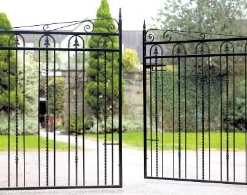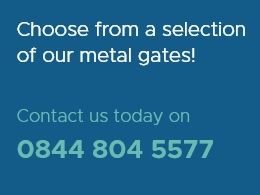A Guide to Gate Locks and Additional Measures to Bolster Security
Are you concerned about the level of security your gate currently provides, or perhaps you are looking for an entire upgrade? If you are then we have created a guide to help you understand the different types of locks you may encounter and have provided you with details of some additional security measures you can implement to ensure your property remains as best protected as possible.
Different Types of Locks for Metal Gates
Padlocks
By far the most common lock used to secure a metal gate in a residential and commercial setting, a padlock is simple to use and provides a very effective means of securing the gateway from unauthorised entry. With a wide range of styles and sizes available to purchase anywhere from specialist retailers to DIY superstores and even your corner shop, they are easy to buy, weather resistant and can be utilised on gates with both a tip latch and a sliding latch.
Positive Benefits
- They are compatible with a variety of applications, gate types and latch designs.
- They represent excellent value for money because a padlock costing a few pounds can protect valuables worth thousands of pounds.
- Simple to install, they can be locked and unlocked in under 10 seconds and don't need any specialist instructions to operate.
Negative Drawbacks
- As the lock remains exposed, it is vulnerable to attack as the shackle can be cut, or the lock body can be drilled. Consequently, they are not as secure as other locking mechanisms with concealed elements.
- The need for a physical key can be cumbersome and runs the risk of it becoming lost or stolen.
- They are only suitable for limited spplications because they need to be manually locked and unlocked and cannot be integrated with complex security systems or remotely secured.
Key Locks
Here's a summary of the three main types of keyed gate locks:
- Weld-in Locks: This type of lock is integrated into the gate frame by welding. To provide the space required for the lock body, a section of the framework needs to be removed. To achieve this, the case of the lock is first welded into the gate framework, and then the inner body of the lock mechanism is fitted.
- Mortise or Insert Locks: This type of lock sits fully within the framework of the gate and does not need a lock case to be installed first.
- Surface-Fixed Locks: Most commonly used for solid infill, composite, or wooden gates, this type of lock is bolted directly to the framework of the gate or mounted to a metal plate welded on (if the components of the gate are not of sufficient size to provide an adequate fixing point).
Positive Benefits
- Integral key locks are more secure than padlocks, where the main components are built into the gate framework. This means they are not easily removed and are less susceptible to being forced with a bar or other tools.
- Because they are built into the gate structure, an integral key lock has an unobtrusive appearance compared to other lock types.
- Integral locks are designed to be strong, robust and durable.
Negative Drawbacks
- They are more expensive to purchase than a padlock and are more complicated to install.
- The use of a physical key poses loss, theft and other potential accessibility and security issues.
- Once installed, it is generally quite difficult to replace or modify this type of lock if it becomes damaged or needs upgrading.
Keypad Locks
Installing a digital keypad onto a gate to enable access will remove the requirement for the user to have a traditional key, as these can often become misplaced, lost, or broken. Furthermore, if you have lots of people who need access through the gate, a keypad lock eliminates the need for multiple keys to be issued. Also, over time, you can periodically change access codes (if a tenant or employee leaves), thus offering an extra layer of protection to the entrance and occupants.
Pros of using a keypad lock on a gate:
- Keyless entry eliminates the need for physical keys.
- Multiple users can have access codes, making it easier to grant entry without the need to manage multiple keys.
- Access control codes can be added or removed as and when needed, making it easier to gain control over who enters the property.
Negative Drawbacks
- Vulnerable to unauthorised access as keypad locks may be subject to code hacking.
- Limited Durability of the electronic components as they are prone to damage and vandalism.
- The batteries require periodic replacement.
Enhancing Security with Additional Features
Intercom Systems
Although expensive to install and only suitable for use with electronic locks, an intercom system will provide occupants of the property with a high level of convenience and peace of mind as visitors will need to identify themselves before access is given.
Gate Closers
A gate closer provides a convenient way to ensure the gate is never accidentally left open.
Motion Activated Lighting
A simple yet effective security deterrent, motion sensor lighting is easy to install and also makes accessing and egressing the entrance safer for occupants.
Choosing the Right Lock & Security System
When trying to decide which gate lock is best for you, it is important to consider individual elements such as the location of the property, the level of security you need and your available budget. Whilst each option detailed above provides features that cater to different needs, the choice is ultimately yours to make.
Do You Need a Lock for Your New Metal Gate?
Here at Metal Gates Direct, all our designs can be secured using a padlock as standard. For those looking to upgrade to use a key, this is only available on our heavy-duty gate designs, including the following:



